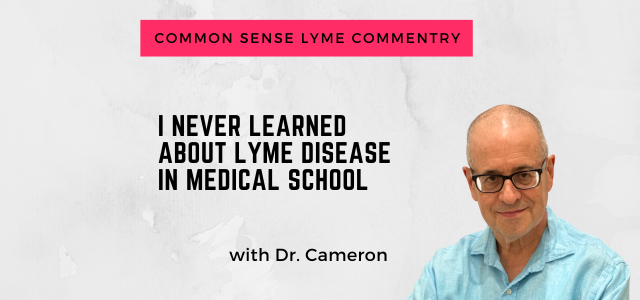
During my medical school, graduate school, and residency, Lyme disease wasn’t even on my radar. That’s not surprising, given that I was in training before Lyme disease had really entered the medical lexicon. Back then, the condition was a little-known illness, limited to a few regions and far from being the major public health concern it is today. The curriculum, understandably, focused on the big, established diseases—heart disease, diabetes, infectious diseases like tuberculosis—leaving little room for something as obscure and geographically specific as Lyme.
A Rare and Localized Disease—Until It Wasn’t
At the time, Lyme disease was considered a rare and localized condition, affecting only a small number of people in the Northeastern United States. It hadn’t yet become the most common vector-borne disease in the country, and the idea of hundreds of thousands of cases annually, as the CDC now estimates, was unimaginable. The reality was that it simply wasn’t on the radar for most doctors in training.
The first inklings of Lyme disease began to emerge in the 1970s and 1980s, with clusters of cases in Connecticut and surrounding areas, but it took years before the disease was widely recognized and even longer before it became a regular part of medical training. By the time I was practicing, Lyme disease had started to gain some attention, but it was still seen as a regional issue—a niche concern rather than a widespread health threat.
A Turning Point: Recognizing the Pattern
It wasn’t until 1987, when I started seeing three patients with a constellation of symptoms—fatigue, joint pain, neurological issues—that didn’t fit neatly into any diagnostic box, that I began to see how much had changed. These were patients who had seen multiple specialists, undergone countless tests, and still had no clear diagnosis. It was in these three patients that I began to recognize the hallmarks of Lyme disease, a condition that, in many ways, had outpaced the medical training I’d received.
These patients taught me about the complexities of Lyme disease—the way it can present with vague, non-specific symptoms that are easy to dismiss or misattribute to other conditions. I learned how it can mimic other diseases, earning it the moniker “The Great Imitator,” and how it can lead to serious, long-term complications if not diagnosed and treated early.
Medicine Evolves, and So Must We
As I learned more about Lyme disease, I realized how much the medical field had shifted since my days as a resident. The complexities of diagnosing Lyme, the limitations of standard tests, and the ongoing debates over chronic Lyme disease were all new territory for me. The standard two-tiered testing approach, while useful in some cases, often falls short, particularly in early or late-stage Lyme disease. I became aware of the growing body of evidence and the passionate discussions among patients, advocates, and healthcare providers about the existence and treatment of chronic Lyme disease or Post-Treatment Lyme Disease Syndrome (PTLDS).
This wasn’t just about Lyme disease, though—it was about how medicine evolves, how new diseases emerge and force us to adapt, to learn, and to rethink our approaches. Medicine is often described as a science, but it’s just as much an art—an art that requires intuition, continuous learning, and a willingness to question and revise what we think we know.
A Lesson in the Ever-Changing Landscape of Medicine
Looking back, the absence of Lyme disease from my early training is a reminder of the ever-changing landscape of medicine. What was once obscure can become central. The diseases we focus on today might not be the ones we need to worry about tomorrow. Lyme disease, with its wide-ranging symptoms and potential for chronic impact, underscores the need for continual learning and adaptability in our field. It’s a humbling reminder that medicine is not static; it’s a field that requires us to stay curious, to keep learning, and to be prepared for the unexpected.
The Importance of Listening and Learning
In many ways, Lyme disease serves as a case study in the challenges and rewards of practicing medicine. It highlights the importance of listening to patients, of considering the whole picture rather than just isolated symptoms, and of staying open to the possibility that what we don’t know—or what we didn’t learn—could be just as important as what we do know. It’s a lesson in humility and the ongoing pursuit of knowledge, both of which are essential in the ever-evolving world of healthcare.



I have lived in Australia all my life.
Got bit by a tick at the age of 18.
2015 found a naturopath and sent blood to Germany.
Come back positive for Lyme disease.
The suffering from Lyme disease i might have well been dead.
As not one doctor or infectious disease specialist believed me.
I finally found a doctor that knew how to read the Germany test results.
I never gave up and so lucky I found her and now I also have a Specialist which both help me with my illness.
And I have 5 chronic illnesses
I am now 54 this year and just get through each day as I can.
I fight for every day as I have one beautiful son that will be 25 this year.
I live for him every day.
Until I can’t go anymore.
I bless and pray everyday for any other that has Lyme disease.
Thanks for the blessing. I hope you get better someday
Im the same age as you Kim and in Tasmania , 4 years ago i got insanely sick very quickly from a tick bite on the back of my neck . Encephalitis, a 14 month migraine , crushing chest pains , lost my memory, i was a full zombie and said good bye to my wife and boys a few times I was sure i would die .i went to hospital in ambulances , cardiology , CT scan’s , infectious diseases clinic , numerous blood tests but they would never test for what I asked , got treated like rubbish , like i made it up which shocked and upset me . I realised I had to treat myself so read everything i could about tick illnesses and had more supplements than a witches larder . I got covid about 20 months later and hit it hard with ivermectin and after It disappeared I started getting better quickly , now 2 years later im 90percent better on average , i still get mild head aches and occasional chest pains . I take sativa cannabis oil cbd, thc at night and ivermectin once every 4 months and life is good . Not saying the same thing will work for you but dont give up hope , if i could get better you could too , you just need to kill the bacteria, virus and parasites, if you have not tried ivermectin id give it a go
I am glad you are 90% better.
Your lastest articles are absolutely wonderful! I wish there were more Lyme literate doctors in the world. I have been struggling with PTLDS for years. In the past I was a patient of yours, during that I actually felt ok. Unfortunately because of the distance I couldn’t continue my treatment at your practice. I would be eternally great full if you could refer me to a Lyme Dr. in CT.
Thank you.
I am glad you felt better for awhile. I hope you get better again. I am not familiar withe the professionals in Connecticut. You may find it helpful to check with GlobalLymeAlliance or ILADS for names if your primary can’t arrange someone for you.
Bless you for managing your horrid disease without the assistance of all those ignorant. pompous so called” Dr.s”. There are so many of us that we have lost to death, assisted suicide and just plain suicide! My brain roars when I hear stories like yours…Take care..Sometimes, it’s too much to take just one day at a time…for the sake of our sanity, we must take it one minute at a time.